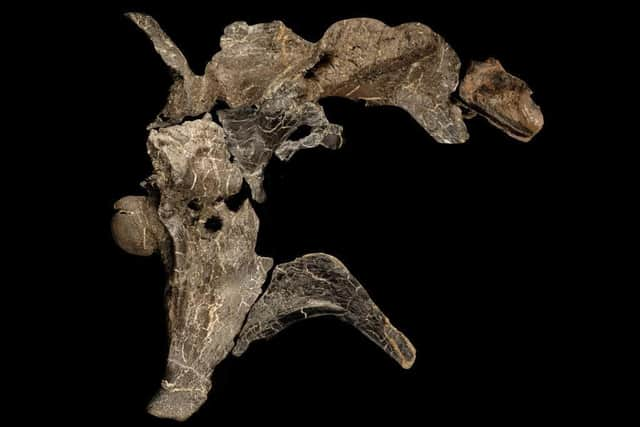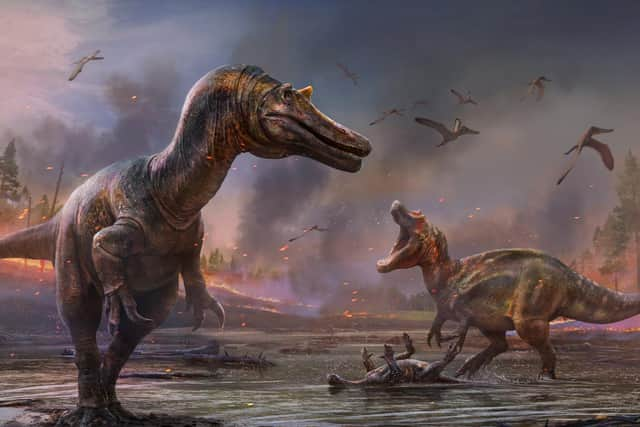Amateur Yorkshire fossil collector helps to unearth two new killer dinosaurs with crocodile-like skulls and razor sharp teeth
The terrifying beasts had bizarre 'crocodile-like skulls' that enabled them to hunt on land - and in the water.
They had razor sharp teeth and claws - and a whip like tail. Bone crushing jaws would have snapped prey in half.
Advertisement
Hide AdAdvertisement
Hide AdBoth species reached 30 feet long, over 10 feet tall and weighed about five tons.


The haul of bones was discovered on the beach near Brighstone Bay on the south west coast over a period of several years.
Keen-eyed fossil collectors initially found parts of two skulls. A crew from Dinosaur Isle Museum in Sandown recovered a large portion of a tail
Amateur fossil collector Brian Foster, from Yorkshire, said: "This is the rarest and most exciting find I’ve made in over 30 years."
Advertisement
Hide AdAdvertisement
Hide AdIn all, over 50 bones have been dug out of rocks laid down over 125 million years ago during the Early Cretaceous.


They are closely related to the giant Spinosaurus - the largest terrestrial meat eater that ever lived.
One has been named Ceratosuchops inferodios - which translates as "horned crocodile-faced hell heron."
Its brow was adorned with a series of low horns and bumps - and it stalked like today's wading bird.
Advertisement
Hide AdAdvertisement
Hide AdHerons famously catch aquatic animals around the margins of waterways. But their diet is far more flexible than generally appreciated.
They can be found in wetlands throughout the world searching for fish, crabs, frogs, small mammals - and even young birds.
The second was named Riparovenator milnerae meaning "Milner's riverbank hunter" - after a revered British palaeontologist.
They belonged to a group of carnivores called spinosaurids. The Isle of Wight' s position at the time was roughly where Gibraltar is now.
Advertisement
Hide AdAdvertisement
Hide AdIt has been dubbed 'Dinosaur Island'. More dinosaur bones have been found there than anywhere else in Europe.
The only spinosaurid skeleton previously unearthed in the UK belonged to Baryonyx - discovered in 1983 in a quarry in Surrey.
Most other finds since have been restricted to isolated teeth and single bones.
Lead author Chris Barker, a PhD student at Southampton University, said: "We found the skulls to differ not only from Baryonyx - but also one another.
Advertisement
Hide AdAdvertisement
Hide Ad"It suggests the UK housed a greater diversity of spinosaurids than previously thought."
The study in Scientific Reports found the skulls alone measured 3ft 3in in length.
Co-author Dr Darren Naish, an expert in British theropod dinosaurs at Southampton, said: "We've known for a couple of decades now that Baryonyx-like dinosaurs awaited discovery on the Isle of Wight.
"But finding the remains of two such animals in close succession was a huge surprise."
Advertisement
Hide AdAdvertisement
Hide AdAnalysis also suggests spinosaurids evolved in Europe - and then dispersed into Asia, Africa and South America.
The most notorious was Spinosaurus or 'spined reptile' which was 50 feet long with a 'sail' on its back - created by tall vertebral spines.
Co-author Dr David Hone, of Queen Mary University of London, said: "It might sound odd to have two similar and closely related carnivores in an ecosystem.
"But this is actually very common for both dinosaurs and numerous living ecosystems."
Advertisement
Hide AdAdvertisement
Hide AdThe Early Cretaceous floodplain environment was bathed in a Mediterranean-like climate.
Whilst generally balmy, forest fires occasionally ravaged the landscape, The remains of burnt wood can be seen throughout the cliffs today.
Fellow collector Jeremy Lockwood, who lives on the Isle of Wight and discovered several bones, said: "We realised after the two snouts were found this would be something rare and unusual.
"Then it just got more and more amazing as several collectors found and donated other parts of this enormous jigsaw to the museum."
Advertisement
Hide AdAdvertisement
Hide AdA large river and other bodies of water attracted dinosaurs and housed various fish, sharks and crocodiles.
The habitat provided the spinosaurids with plenty of hunting opportunities.
Project supervisor Dr Neil Gostling, also from Southampton, said: "This work has brought together universities, Dinosaur Isle museum and the public to reveal these amazing dinosaurs and the incredibly diverse ecology of the south coast of England 125 million years ago."
It also cements the Isle of Wight's status as one of the top locations for dinosaur remains.
Advertisement
Hide AdAdvertisement
Hide AdThe fossils described in Scientific Reports are to go on display at Dinosaur Isle Museum.
Curator Dr Martin Munt congratulated the collectors and scientists for the "amazing finds."
Dr Angela Milner, after whom Riparovenator is named, recently passed away.
She had previously studied and named Baryonyx – substantially improving our understanding of the spinosaurids.
Comment Guidelines
National World encourages reader discussion on our stories. User feedback, insights and back-and-forth exchanges add a rich layer of context to reporting. Please review our Community Guidelines before commenting.